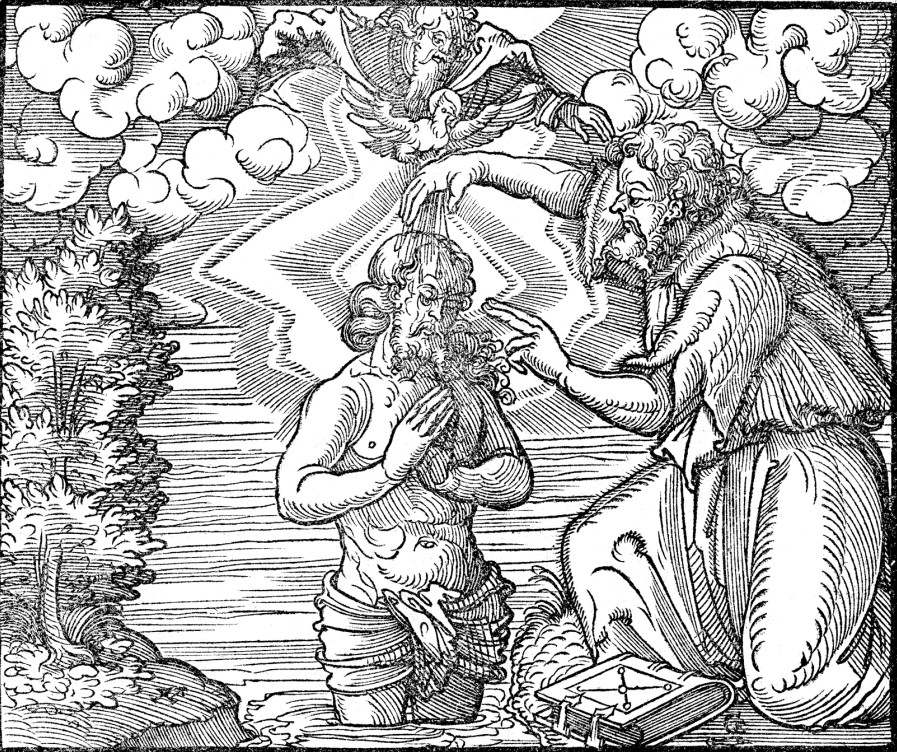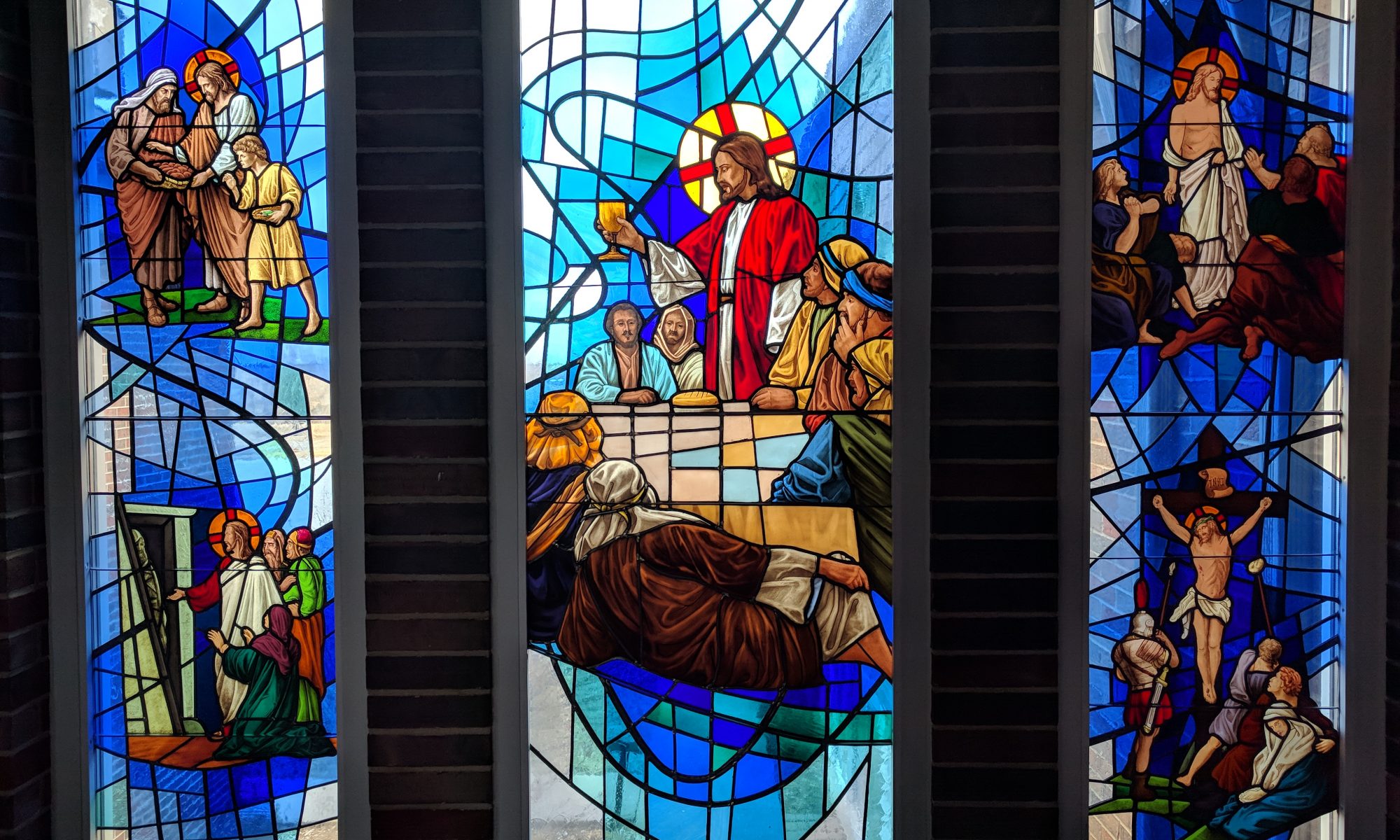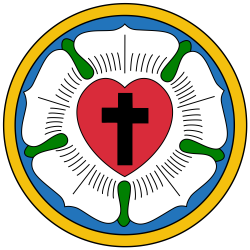
Lessons: Joshua 3:1-3, 7-8, 13-17; 1 Corinthians 1:26-31, Matthew 3:13-17
Hymns: LSB 401, 406, 839, 404, 405
Grace, mercy, and peace to you from God our Father and our Lord and Savior, Jesus Christ. Amen.
As we consider the Baptism of our Lord today, I want to focus on three things: 1) the rite of Baptism and its blessings, 2) the water used in Baptism, and 3) the significance of Christ’s own Baptism.
Baptism is a short and simple rite. Applying water to the one being baptized, the officiant says, “I baptize you in the name of the Father and of the Son and of the Holy Spirit.” That’s it. Yet our baptismal liturgy is four pages long—far longer than the actual rite of Baptism.
Feel free to take some time to look at in on pages 268-271 in LSB.
The main reason for the length of the baptismal liturgy is that is how we inherited it. Our fathers before us practiced an order like ours. In fact, much of it was used before the Reformation.
For the last seven years, you have heard me bring up things that happened 500 years ago with the Reformation. As we begin this new year, I am going to give you a glimpse yet again into our church’s history from 500 years ago. From 1521 to 1522, Martin Luther was in the Wartburg Castle in hiding because he was considered an outlaw by the Roman Empire. His safekeeping there was arranged by the local prince, Elector Frederick the Wise. While in hiding at the castle, Martin Luther translated the New Testament from the original Greek into German to allow German-speaking Christians to read the Bible in their own language. After returning to Wittenberg, Luther did not end his work of translating.
In 1523, Martin Luther translated two important works in the liturgical life of the Church. First, he translated the Divine Service from Latin into German. He omitted everything that was contrary to the Word of God, including exhortations to the saints and Mary. He introduced chanting the Words of Institution so that the people may hear this important blessing of the elements to be used for Holy Communion. Luther also added the Aaronic Benediction at the end of the service, using the blessing found in Numbers 6:22-27, “The Lord bless you and keep you, etc.” Luther’s German service is Divine Service V in Lutheran Service Book (p. 213), which we usually use on Trinity Sunday and Reformation Day.
The second work Luther translated in 1523 was an Order for Baptism. Until that time, it had commonly been performed in Latin and included several additions that were contrary to Scripture. Yet, Luther was hesitant to make too many changes, so he retained a few portions that were questionable at best. The first is blowing below the baby’s eyes three times before saying the exorcism (that exorcism, by the way is retained in which the pastor says, “Depart you unclean spirit and give room to the Holy Spirit”). Also, the pastor put salt in the baby’s mouth, saying, “Receive the salt of wisdom. May it aid you to eternal life.” Finally, Luther instructed pastors to spit on their fingers and touch the right ear of the baby, saying, “Ephphatha, that is, be opened” (Mark 7:34). Then touch the nose and the left ear, saying, “But you, devil, flee; for God’s judgment comes speedily.”
From Luther’s Order for Baptism of 1523, we have retained the custom of the exorcism (found in the LSB Lutheran Agenda), praying what has become known as Luther’s Flood Prayer, enrolling godparents, reading Mark 10:13-16, praying the Lord’s Prayer, making the sign of the cross on the baby’s forehead and heart, renouncing the devil, confessing the Apostles’ Creed, and receiving a candle to indicate that the light of Christ has been received. These are all wonderful customs, but the important part is to retain the actual rite of Baptism using water and the simple words of “I baptize you in the name of the Father and of the Son and of the Holy Spirit.”
These words are placed upon you each Sunday at the beginning of the Divine Service. I say them when standing at the Baptismal font to remind you of your own Baptism. Then we confess our sins and receive the Absolution—forgiveness from the pastor as from God Himself—forgiveness that continues to flow forth to you because of your standing before God as a baptized child of God.
Even though the actual rite of Baptism is very short, wondrous things take place. God receives sinners into His family. They are adopted into God’s royal family; they become children of God. Jesus becomes their Brother, and they then enjoy the same standing before God as God’s only begotten Son. That is, God treats each of us as His firstborn to receive an eternal inheritance. In addition, our sins are downed and die, and we arise to newness of life. We are joined to the death and resurrection of Jesus in our Baptism, and we are clothed in the very righteousness of Christ. We are washed and cleansed, justified and sanctified, buried and raised, killed and made alive—all in that simple act of Baptism. Clearly, Baptism is the work of God as He saves us, regenerates us, forgives us, and clothes us in Christ.
Sadly, only Lutherans teach that God does all this in Baptism. Most protestants understand Baptism to be a work of the individual in which he commits himself to Christ. Some churches which practice infant Baptism assert that forgiveness is only granted for the sins committed up until Baptism. Because of this, we must remain steadfast, committing ourselves only to the truth of God’s Word, and always being ready to give a reason for the hope that is within us.
Some denominations insist that we Lutherans apply water wrongly or use the wrong water. Some think the Greek word βαπτίζω means to immerse. But Mark 7:4 reports that the Pharisees washed (Greek βαπτίζω) couches before they used them to dine on at each meal. Clearly the word is not limited to immersion but was used in Greek for washing. Other churches insist on using some sort of holy water. That is not found in our Lord’s command. The water used by John was flowing water in the Jordan. It was not contained so that it could be blessed. The water we use in Baptism is simply tap water.
There’s an interesting connection between the Jordan and the giving of life, which ironically flows into the Dead Sea (so named because plants and fish can’t live in that very salty sea, but algae and microorganisms do). The Jordan is first mentioned when Abraham and Lot’s flocks are getting too large, and they must part ways to sustain their flocks. Lot chooses the fertile land in the Jordan Valley. Baptism brings a lavish bestowal of God’s grace. The Jordan served as a geographical boundary and God stopped the river’s flow as Joshua and the people of Israel crossed over to the Promised Land. Baptism brings us into the Promised Land of Christ’s Kingdom. The prophet Elijah told Naaman the Syrian to dip in the Jordan River to be cleansed of his leprosy. The Lord cleanses us of the leprosy of sin in Baptism.
When Jesus came to the Jordan to have John the Baptist baptize Him, John initially objected, saying, “I need to be baptized by You, and do You come to me?” But Jesus said, “Let it be so now, for thus it is fitting to fulfill all righteousness” (Matt. 3:13-15). John knew that Jesus is perfect and did not need Baptism to be cleansed of sin. But he didn’t realize how God would work His plan of salvation when Jesus is baptized. In the Baptism of Jesus, He is anointed as the Anointed One. He is marked as the very Messiah who is promised to come—the Christ. He takes on our sin so that we can become the righteousness of God. As it is written, “For our sake [God] made Him to be sin who knew no sin, so that in Him we might become the righteousness of God” (2 Cor. 5:21). The wonderful working of God in our Lord’s Baptism is also demonstrated by the heavens being opened and the Spirit of God descending upon Him like a dove. And God the Father speaks, “This is My beloved Son, with whom I am well pleased” (Matt. 3:16-17).
Just as God was at work in our Lord’s Baptism, so also the same God is at work when sinners are baptized into Christ today. In the Baptism of our Lord, the heavens were opened, and, in the same way, Heaven is opened to you when you are covered with the very righteousness of Christ in your Baptism. The Father is also well pleased with you, because you have the same standing before Him as Christ does by virtue of your own Baptism. What blessings you have in Baptism!
And these blessings are not some sort of past-tense thing that only happened at the time of your Baptism. You see, it is inaccurate to say that you were baptized. Instead, your Baptism declares who you are in the here and now. We don’t say say, “I was naturalized” when speaking to our current status as an American citizen. Instead, we say, “I am a citizen.” In the same way, we talk about being baptized for that is our current standing. Not “I was baptized,” but “I am baptized.”
I think there’s a temptation to think of Baptism as merely some sort of church rite that has little to do with real life. But that cannot be further from the truth. You see, real life is the life God intends; it isn’t some secular life apart from God. Real life is first and foremost a life with God as members of His family. It then extends into having our own families, jobs, and various vocations. But it begins with being a citizen of God’s kingdom through Baptism. The real life involves participation in the Divine Service, prayer, family devotions, and charity. And this life begins with Baptism and continues until that time our bodies are laid to rest and our souls go to be with the Lord. In fact, that real life continues even further, for Christ Jesus will return on the Last Day and resurrect our bodies and we will dwell with Christ in real life for the end of time in all perfection, giving our praises to God. This, my friends, is given to us in our Baptism! Amen.
The peace of God which passes all understanding keep your hearts and minds in Christ Jesus to life everlasting. Amen

